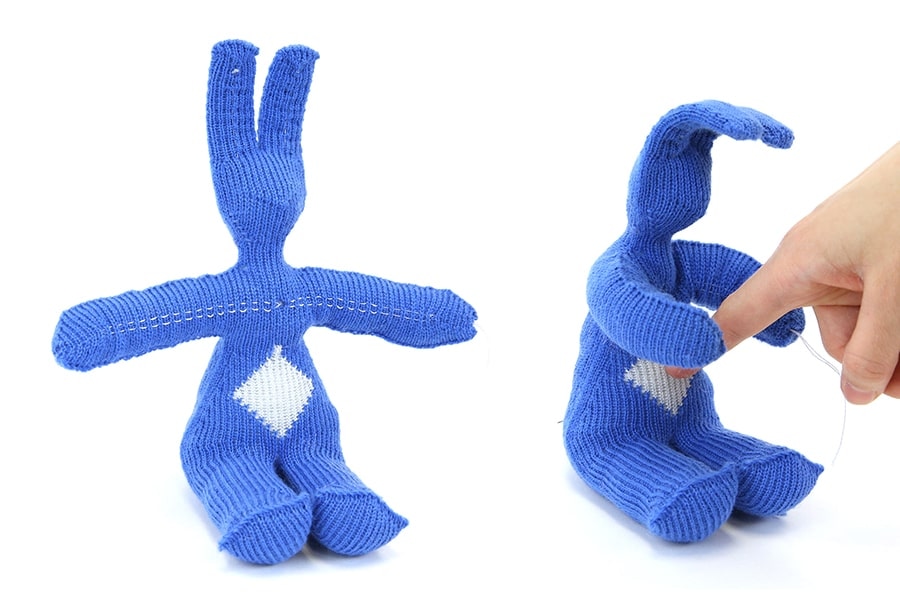May 3 2019
Scientists at Carnegie Mellon University have employed computationally controlled knitting machines to make plush toys and other knitted objects that are activated by tendons.
 PhD student Lea Albaugh developed a tendon-embedding technique to create knitted objects such as lampshades that change shape. (Image credit: Carnegie Mellon University)
PhD student Lea Albaugh developed a tendon-embedding technique to create knitted objects such as lampshades that change shape. (Image credit: Carnegie Mellon University)
It is a technique that is expected to be used in the future to develop soft robots and wearable technologies economically.
Software created by scientists from CMU’s Morphing Matter Lab and Dev Lab in the Human-Computer Interaction Institute enables the objects to come out of the knitting machines in their needed shapes and with already embedded tendons. They can subsequently be filled and the tendons can be fitted to motors, as required.
Lea Albaugh, a PhD student who headed the research work, created the tendon-embedding method and investigated this design space to produce lampshades that modify shape, stuffed toys that give hugs when pushed in the stomach and also a sweater with a sleeve that rolls by itself. While mostly unbelievable, these objects show potentials that could finally have significant applications, for example, soft robots.
Soft robotics is a growing field. The idea is to build robots from materials that are inherently safe for people to be near, so it would be very hard to hurt someone. Actuated soft components would be cheap to produce on commercial knitting machines. We have so many soft objects in our lives and many of them could be made interactive with this technology. A garment could be part of your personal information system. Your sweater, for example, might tap you on your shoulder to get your attention. The fabric of a chair might serve as a haptic interface. Backpacks might open themselves.
Lea Albaugh, PhD student, Carnegie Mellon University.
Albaugh and her co-researchers, HCII faculty members Scott Hudson and Lining Yao, will exhibit their work at CHI 2019, the Association for Computing Machinery’s Conference on Human Factors in Computing Systems, held from May 4th to 9th in Glasgow, Scotland.
Although commercial knitting machines are well-built and are extensively employed, they usually need rigorous programming for each garment. This new study is based on earlier CMU work to automate the process, rendering it simpler to use these mass production machines to make customized and one-off designs.
It’s a pretty convenient pipeline to use for producing actuated knitted objects.
Lining Yao, Assistant Professor, HCII.
She remarked that other scientists have carried out experiments with actuated textile objects, but have been confronted with the time-consuming job of embedding tendons to finished items. Adding tendons in the materials while they are being developed saves time and effort, and improves the precision of the actuation.
The scientists devised techniques for embedding tendon trails vertically, horizontally, and diagonally in fabric tubes and sheets. They demonstrated that the shape of the fabric, together with the orientation of the tendon path, can give rise to a range of motion effects. These include S-shaped bends, asymmetric bends, and twists. The firmness of the objects can be attuned by filling them with a variety of materials, like those available to hobbyists.
Several tendon materials can be used, for example, pure silk yarn, polyester-wrapped quilting thread, and nylon monofilament.
These methods not only actuate the objects but also can incorporate sensing abilities to objects. For example, by fitting sensors to each tendon, the direction in which the object is being twisted or bent can be detected. By weaving with conductive yarn, investigators demonstrated that they could develop contact pads for capacitive touch sensing as well as strain sensors to sense if a swatch is expanded.
According to Albaugh, 3D printing is already being employed to create tailored, actuated objects and robotic components; however, the materials usually used are tough. Computationally controlled knitting has the capability to increase the opportunities and to render the outcomes more people-friendly.
“I think there’s enormous power in using materials that people already associate with comfort,” she said.
This research project was partly supported by the National Science Foundation.
Digital Fabrication of Soft Actuated Objects by Machine Knitting (Teaser Version)
Digital fabrication of soft actuated objects by machine knitting from Morphing Matter Lab on Vimeo.